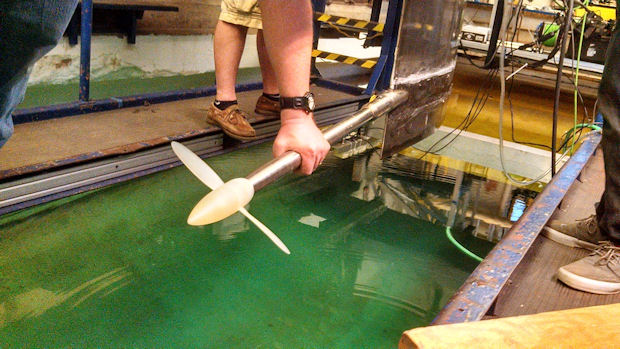
Fig. 1. The 3D-printed human-powered submarine propeller. It’s produced by Burton Precision on a 3D Systems ProJet 3500 HDMax printer from a plastic material called Crystal. The propeller blade assembly is 10-in. long.
August 1, 2014
 Fig. 1. The 3D-printed human-powered submarine propeller. It’s produced by Burton Precision on a 3D Systems ProJet 3500 HDMax printer from a plastic material called Crystal. The propeller blade assembly is 10-in. long.
Fig. 1. The 3D-printed human-powered submarine propeller. It’s produced by Burton Precision on a 3D Systems ProJet 3500 HDMax printer from a plastic material called Crystal. The propeller blade assembly is 10-in. long.Grand Rapids, Michigan-based Burton Precision is a machine tool distributor specializing in the application of metrology and 3D printing products. Their involvement in manufacturing crisscrosses the breadth of industries with technologies that have a direct impact on successful product design and manufacture.
The University of Michigan’s Human Submarine Team recently contacted Burton Precision to enlist its assistance: The team was dealing with some CAD issues related to producing a propeller for a submarine that is designed and built by students.
Rick Kerkstra, Burton Precision vice president and 3D printing specialist, recounts that this particular inquiry came through a circuitous path.
“We held an open house at Burton Precision for GR Makers in Grand Rapids, which is an open community lab that incorporates elements of a machine shop, a workshop and a design studio,” he explains. “Members there work on projects that range from the industrial to the delicate arts. It’s a unique community that focuses on enabling personal expression, providing education and supporting entrepreneurship.”
 Fig. 2. Rick Kerkstra, Burton Precision vice president, performed the coordinate measuring of the propeller with a portable CMM arm at Burton’s demo facility in Grand Rapids, MI.
Fig. 2. Rick Kerkstra, Burton Precision vice president, performed the coordinate measuring of the propeller with a portable CMM arm at Burton’s demo facility in Grand Rapids, MI.Kerkstra was demonstrating Burton’s metrology and 3D printing products when one of the GR Makers staffers mentioned that his brother belonged to the Human 3D Printed Propeller for Human Powered Submarine Team at the University of Michigan.
“He said they were having problems with a point cloud file for a propeller design,” Kerkstra recalls. “More specifically, they couldn’t convert the file to a ‘friendly’ file that they could put to a cutter path on a computer numerically controlled (CNC) machine to make the part. I gave him my card, and Jeremy Werner called.”
Werner is with the University of Michigan’s Naval Architecture and Marine Engineering Department — and president of the Human Powered Submarine Team. He notes that the CAD issues they were having with a propeller design program called Open Prop, which wasn’t allowing them to export files in a format that they could use to create a toolpath. Werner provided Burton Precision with the point cloud files that did not include outward normal vectors.“The units were in meters and arranged with 100 rows of points along the length of the prop blade, and 40 points per row — 20 on either side of the blade,” Kerkstra says. “Ultimately, they wanted to make the toolpath in GibbsCAM.
“I think Jeremy and I had about 14 emails the first week, so it wasn’t as simple as a file conversion,” Kerkstra continues. “It usually never is.”
Werner sent an STL file, which Kerkstra read into Geomagic Studio Software in an attempt to create a nurbs surface — a mathematical model commonly used in computer graphics for generating and representing curves and surfaces. Geomagic is a 3D Systems software package that is used on 3D Systems Printing machines.”
“We were dealing with low-resolution files and an edge on the blade that was giving the surface creation fits,” Kerkstra recalls. “Jeremy did four or five rewrites before we had a file that we could use. Once we had a good surface file to give back to him, I asked if we could 3D print it for him — and that opened another door.”
Kerkstra and Werner had further discussions about strength of material, testing using a scale version and overall functionality of the 3D printed part. “The first surface files that we provided failed the initial testing in their simulator because the blade thickness was too thin,” Kerkstra says. “That was enlarged and the thicker blade passed.”
Kerkstra and his team 3D printed the propeller on a 3D Systems ProJet 3500 HDMax printer in a plastic material called Crystal. The blade assembly was 10-in. long.
 Fig. 3. Testing of the 3D-printed propeller was successfully performed on the test stand at the University of Michigan’s Engineering Department.
Fig. 3. Testing of the 3D-printed propeller was successfully performed on the test stand at the University of Michigan’s Engineering Department.“For projects like what we provided for this propeller design, one to two days is necessary to complete the data conversion, if we have clean printable files,” Kerkstra says. “Because 3D Printing technology is new to most of our customers, we still have to do some educating as to what it takes to develop a 3D printable file — that it ultimately takes only a few hours to print the part.”
Werner agrees. “Burton Precision became a key player in providing a hands-on learning experience for me and all the team members involved in the scale model propeller test,” he adds. “This kind of out-of-the-classroom training is at the core of our team’s mission statement, and everyone from outside U of M who contributes to that deserves special recognition.”
On April 22, the Burton team attended the full-scale, self-propelled test of the submarine. “The test was successful — the propeller worked perfectly,” Kerkstra reports.
More Info
Subscribe to our FREE magazine, FREE email newsletters or both!
About the Author
DE’s editors contribute news and new product announcements to Digital Engineering.
Press releases may be sent to them via [email protected].






